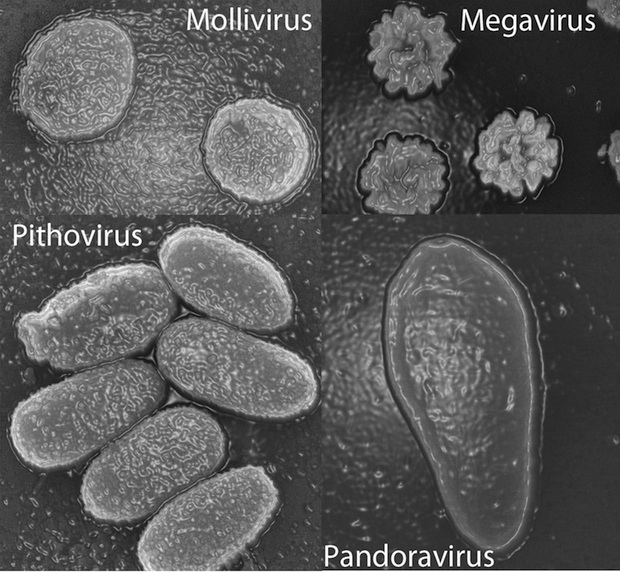Should be we scared of this ancient, giant virus?
When Chantal Abergel and her colleagues discovered their first family of giant viruses 12 years ago, they sensed the were onto something big.
They found their second family - so named because they are as much as 30 times bigger than your typical virus - in the Pacific Ocean off Chile in 2013 and named it Pandoravirus, a reference, they said, to opening Pandora's box. A second Pandoravirus was discovered at the same time in an Australian pond.
A year later, the team turned their attention to permafrost in Siberia that was much as 30,000 years old. Scientists there had just pulled seed from a chunk of this frozen tundra and brought a flower back to life.
"We thought if they can revive plants, we should be able to reactivate a virus," Abergel, an evolutionary biologist at Aix-Marseille University in France and the Information Génomique & Structurale, told CBS News. "A plant is much more complex than a virus so we should be able to rescue a virus."
So they ordered up a sample of the permafrost and went to work. Last year, they discovered a new giant virus named Pithovirus sibericum in the permafrost. And this week, the team announced a second virus, Mollivirus sibericum, living in the same permafrost sample.
"Wow," Abergel said, recalling the moment they found the latest virus in the soil that at 1.5 micrometers is the biggest ever found.
"We were fascinated actually and wanted to go deep into the understanding of that virus," she said. "Now we need a modern one to compare and understand how those viruses evolve. We know one is out there but we are waiting for the genome of the modern one so we can compare them."
Describing the discovery in the Proceedings of the National Academy of Sciences, the scientists were surprised that this new family of virus maintained its ability to infect after being frozen for so long.
And unlike today's viruses, they found they were far more genetically complex - even more complex than the genome of some bacteria.
M. sibericum, for example, has more than 500 genes, while Pandoraviruses have 2,500. The Influenza A virus, by contrast, has eight genes.
"Almost 90 percent of the proteins in Pandoravirus don't resemble any other protein on the earth," she said. "It does open a window on new metabolic pathways, new ways to transform the building blocks of life."
After discovering Pandoravirus last year, Abergel and one of her co-authors and husband Jean-Michel Claverie wrote that these giant viruses demonstrated that the assumption any virus can be eradicated is wrong and shows how little we still know about Earth's biodiversity.
"These giant viruses exhibit a very large proportion of genes without any resemblance with the millions that have been characterized in known organisms," they wrote.
"Part of what we don't know might turn out to contain the explanation to fundamental questions such as the origin of life on our planet, and the evolutionary relationship between viruses and the world of cells," they said. "It may also reveal new metabolic pathways and biochemical processes from which new drugs and biotechnological applications might emerge."
Paul Roepe, co-director of the Center for Infectious Disease at Georgetown University Medical Center, told CBS News that there was "huge scientific interest in these discoveries" and that the findings could provide insight into how viruses evolved.
"Going back in time in the permafrost, it tells us something about how viruses evolved on the planet and figured out how to jump from one species to the next," Roepe said.
"Viruses hijack host machinery to replicate themselves," he said. "The theory is that, as they got better and better at that, they lost more and more of their own genome because they figured out how to hijack host cell genes to produce the stuff they need for their replication."
The researchers were careful to say these monster viruses don't pose a threat to humans - even the ones found 100 feet down in the permafrost. While they were able to revive and even reproduce the viruses in the lab, so far they have been only able to infect amoeba, which may have mistaken them for its favorite meal of bacteria.
"We verified that those viruses won't infect mammalian cells," she said. "People should not be worried about these giant viruses."
Still, they warned that could change as global warming thaws the permafrost and the race heats up to develop frigid regions of the world. As companies drill and mine in places like Siberia and the Arctic, the researchers warned they could unearth more of these giant viruses - perhaps one that could be harmful to humans.
"Before prospecting those areas, people should be conscious that they have to take minimum safety precautions," Abergel said.
"We don't know what is in this permafrost," she said. "It should be checked before drilling and mining brings them back to the surface. Nobody knows the full diversity that could be in the permafrost. Some could be a threat to humans."
Roepe said he didn't doubt there are "certainly viruses deep down in the permafrost in various regions around the globe that will give us huge surprises."
But he questioned whether humans have to worry about them anytime soon - partly because the viruses are designed to infect something way down the food chain like microbes and would have to evolve significantly before they could infect us.
"What the relative risk is compared to all the other risks out there, I think it's incredibly small," he said of being infected by any of these viruses. "If you smoke cigarettes and you are worried about this stuff, you are an idiot because I would rather see you stop smoking."

